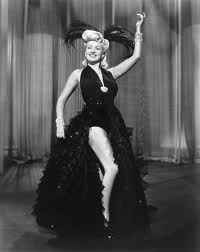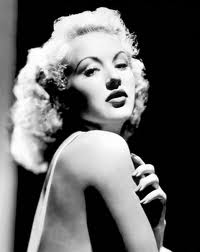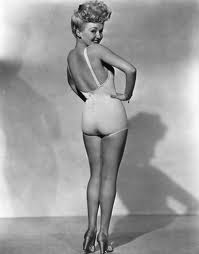Betty Grable (December 18, 1916 – July 2, 1973) was an American actress, dancer and singer.
Her iconic bathing suit photo made her the number-one pin-up girl of the World War II era. It was later included in the LIFE magazine project "100 Photos that Changed the World". Grable was particularly noted for having the most beautiful legs in Hollywood and studio publicity widely dispersed photos featuring them. Hosiery specialists of the era often noted the ideal proportions of her legs as: thigh (18.5") calf (12"), and ankle (7.5"). Grable's legs were famously insured by her studio for $1,000,000 with Lloyds of London.
Early life
She was born Elizabeth Ruth Grable in St. Louis, Missouri to John Conn Grable (1883–1954) and Lillian Rose Hofmann (1889–1964). She was the youngest of three children.Most of Grable's immediate ancestors were American, but her distant heritage was of Dutch, Irish, German and English stock. She was propelled into the acting profession by her mother. For her first role, as a chorus girl in the film Happy Days (1929), Grable was only 12 years old (legally underage for acting), but, because the chorus line performed in blackface, it was difficult to tell how old she was. Her mother soon gave her a make-over which included dyeing her hair platinum blonde.
Career
For her next film, her mother got her a contract using a false identification. When this deception was discovered, however, Grable was fired. Grable finally obtained a role as a 'Goldwyn Girl' in Whoopee! (1930), starring Eddie Cantor. Though Grable received no billing, she led the opening number, "Cowboys." Grable then worked in small roles at different studios for the rest of the decade, including the Academy Award-winning The Gay Divorcee (1934), starring Fred Astaire and Ginger Rogers, where she was prominently featured in the number "Let's K-nock K-nees".In the late 1930s, Grable signed a contract with Paramount Pictures, starring in several B movies, mostly portraying co-eds. Despite playing leads, the typecasting proved to hurt her career more than it was helpful. In 1939, Grable appeared with her then husband, Jackie Coogan (married in 1937), in Million Dollar Legs, from which her nickname is taken. They divorced later that same year (October 1939). After small parts in over 50 Hollywood movies through the 1930s, Grable finally gained national attention for her stage role in the Cole Porter Broadway hit Du Barry Was a Lady (1939). When her contract at Paramount expired, Grable decided to quit acting, being fed up with appearing in college films.
In a 1940 interview, she said that she was "sick and tired" of show business and had decided to retire, but changed her mind - she received an unsolicited offer to go on a personal appearance tour, which she accepted and which led to Darryl F. Zanuck offering her a bigger contract, which she accepted, and which was followed by a part in Buddy DeSylva's Broadway show Du Barry Was a Lady and a part replacing the suddenly ill Alice Faye in Down Argentine Way. "If that's not luck I don't know what you'd call it" Grable said. "I've had contracts with four studios in 10 years and each time I left one or was dropped, I stepped into something better."
Grable's famous pin-up.
It was during her reign as box office queen in 1943 that Grable posed for her famous pinup photo, which (along with her movies) soon became escapist fare among GIs fighting in World War II. The image was taken by studio photographer Frank Powolny. It was rumored that the particular pose and angle were chosen to hide the fact that Grable was pregnant at the time of the photo. In the stage play (1951) and motion picture (1953), of Stalag 17, Stanislas "Animal" Kasava, (Robert Strauss) is infatuated with her, spending his day staring at her photographs. "I seen all your pictures six times" he says "I would not even open the popcorn."
Starting in 1942, Grable was named in the top 10 box office draws for 10 consecutive years. For eight of those ten years, she was the top female-box office star. In 1943, she was named the #1 movie box office attraction. By the end of the 1940s Grable was the highest-paid female star in Hollywood, receiving $300,000 a year. During the 1940s and early 1950s, thirty Fox films were among the top ten highest grossing films of the year. Of those, ten were movies featuring Grable; eight of those movies were Fox's highest grossing pictures for their repesctive years.
Grable was even the heroine of a novel, Betty Grable and the House with the Iron Shutters, written by Kathryn Heisenfelt, published by Whitman Publishing Company in 1943. While the heroine is identified as the famous actress, the stories are entirely fictitious. The story was probably written for a young teenage audience and is reminiscent of the adventures of Nancy Drew. It is part of a series known as "Whitman Authorized Editions", 16 books published between 1941-1947 that featured a film actress as heroine.
Her postwar musicals included: That Lady in Ermine (1948) with Douglas Fairbanks Jr., When My Baby Smiles at Me (1948) again with Dailey, Wabash Avenue (1950) (a remake of Grable's own Coney Island) with Victor Mature, My Blue Heaven (1950), and Meet Me After the Show (1951). Studio chief Darryl F. Zanuck lavished his star with expensive Technicolor films, but also kept her busy — Grable made nearly 25 musicals and comedies in 13 years. Her last big hit for Fox was How to Marry a Millionaire (1953) with Lauren Bacall and Marilyn Monroe. Grable next starred in Three for the Show (1955) with Jack Lemmon; this film was one of her last musicals.
Grable's later career was marked by feuds with studio heads. At one point, in the middle of a fight with Zanuck, she tore up her contract and stormed out of his office. By 1953, Zanuck was grooming Marilyn Monroe to replace Grable as the Fox's resident sex symbol. Far from feeling threatened, on the set of How to Marry a Millionaire Grable famously said to Monroe, "go and get yours, honey! I've had mine". It was at this point that Grable lost her father 'Conn' Grable in 1954, at age 71.
Grable returned to the studio for one last film, How to Be Very, Very Popular (1955) with Sheree North. Following this, Grable hoped to secure the role of Miss Adelaide in the film version of the musical Guys and Dolls. However, when producer Samuel Goldwyn learned that Grable skipped a meeting with him because one of her dogs had taken ill, he became incensed and removed her from consideration. Vivian Blaine, who had originated the role on Broadway, was ultimately cast.
Having left movies entirely, she made the transition to television and starred in Las Vegas. It was in these transition years to stage, when Betty lost her mother Lillian in 1964, at age 75. By 1967, she took over the lead in the touring company of Hello, Dolly!. She starred in a 1969 musical called Belle Starr in London, but it was savaged by critics and soon folded.
Grable's last role was Billie Dawn in Born Yesterday, at the Alhambra Dinner Theatre in Jacksonville, Florida in February 1973.
Personal life
In 1937, Grable married another famous former child actor, Jackie Coogan. He was under considerable stress from a lawsuit against his parents over his childhood earnings and the couple divorced in 1939.In 1943, she married trumpeter Harry James. The couple had two daughters, Victoria and Jessica. They endured a tumultuous 22-year marriage that was plagued by alcoholism and infidelity. The couple divorced in 1965. Grable entered into a relationship with a dancer, Bob Remick, several years her junior. Though they did not marry, their romance lasted until the end of Grable's life.
Death
Grable died July 2, 1973, of lung cancer at age 56 in Santa Monica, California. Her funeral was held July 5, 1973, 30 years to the day after her marriage to Harry James — who, in turn, died on what would have been his and Grable's 40th anniversary, July 5, 1983. She was interred in Inglewood Park Cemetery, in Inglewood, California.Among the lumunaries attending her funeral were her ex-husband Harry James, Dorothy Lamour, Shirley Booth, Mitzi Gaynor, Johnnie Ray, Don Ameche, Cesar Romero, George Raft, Alice Faye and Dan Dailey. "I Had the Craziest Dream," the haunting ballad from "Springtime in the Rockies," was played on the church organ. This song was introduced in the film by Helen Forrest.
Posthumous recognition
Grable has a star on the Hollywood Walk of Fame at 6525 Hollywood Boulevard. She also has a star on the St. Louis Walk of Fame, and was inducted into the Hall of Famous Missourians in 2009.Hugh Hefner, founder of Playboy noted on National Public Radio's Morning Edition on April 23, 2007, in an interview with Terry Gross that Grable was his inspiration for founding the Playboy empire.
Filmography
| Title | Year | Role | Director | Co-stars | Notes |
|---|---|---|---|---|---|
| Happy Days | 1929 | Chorus Girl | Benjamin Stoloff | Uncredited | |
| Let's Go Places | 1930 | Chorine | Frank R. Strayer | Uncredited | |
| New Movietone Follies of 1930 | 1930 | Chorine | Benjamin Stoloff | Uncredited | |
| Whoopee! | 1930 | Goldwyn Girl | Thornton Freeland | Uncredited | |
| Kiki | 1931 | Goldwyn Girl | Sam Taylor | Mary Pickford | Uncredited |
| Palmy Days | 1931 | Goldwyn Girl | A. Edward Sutherland | Uncredited | |
| The Greeks Had a Word for Them | 1932 | Hat Check Girl | Lowell Sherman | Uncredited | |
| Probation | 1932 | Ruth Jarrett | Richard Thorpe | Grable's first credited role | |
| The Age of Consent | 1932 | Student at Dormitory | Gregory La Cava | Uncredited | |
| Hold 'Em Jail | 1932 | Barbara Jones | Norman Taurog | ||
| The Kid from Spain | 1932 | Goldwyn Girl | Leo McCarey | Uncredited | |
| Cavalcade | 1933 | Girl on couch | Frank Lloyd | Uncredited | |
| Child of Manhattan | 1933 | Lucy McGonegle | Edward Buzzell | ||
| Melody Cruise | 1933 | First Stewardess | Mark Sandrich | Uncredited | |
| What Price Innocence? | 1933 | Beverly Bennett | Willard Mack | ||
| The Sweetheart of Sigma Chi | 1933 | Band Singer with Ted Fio Rito | Edwin L. Marin | ||
| The Gay Divorcee | 1934 | Dance Specialty | Mark Sandrich | ||
| Student Tour | 1934 | Cayenne | Charles Reisner | ||
| By Your Leave | 1934 | Frances Gretchell | Lloyd Corrigan | ||
| The Nitwits | 1935 | Mary Roberts | George Stevens | ||
| Old Man Rhythm | 1935 | Sylvia | Edward Ludwig | ||
| Collegiate | 1936 | Dorothy | Ralph Murphy | ||
| Follow the Fleet | 1936 | Trio Singer | Mark Sandrich | ||
| Don't Turn 'em Loose | 1936 | Mildred Webster | Benjamin Stoloff | ||
| Pigskin Parade | 1936 | Laura Watson | David Butler | ||
| This Way Please | 1937 | Jane Morrow | Robert Florey | Charles 'Buddy' Rogers | |
| Thrill of a Lifetime | 1937 | Gwen | George Archainbaud | The Yacht Club Boys | |
| College Swing | 1938 | Betty | Raoul Walsh | ||
| Give Me a Sailor | 1938 | Nancy Larkin | Elliott Nugent | ||
| Campus Confessions | 1938 | Joyce Gilmore | George Archainbaud | Grable received top billing for the first time | |
| Man About Town | 1939 | Susan Hayes | Mark Sandrich | ||
| Million Dollar Legs | 1939 | Carol Parker | Nick Grinde | ||
| The Day the Bookies Wept | 1939 | Ina Firpo | Leslie Goodwins | Joe Penner | |
| Down Argentine Way | 1940 |
| Irving Cummings | ||
| Tin Pan Alley | 1940 | Lily Blane | Walter Lang | ||
| Moon Over Miami | 1941 | Kathryn 'Kay' Latimer | Walter Lang | ||
| A Yank in the RAF | 1941 | Carol Brown | Henry King | Tyrone Power | |
| I Wake Up Screaming | 1941 | Jill Lynn | H. Bruce Humberstone | Grable's only straight dramatic role | |
| Song of the Islands | 1942 | Eileen O'Brien | Walter Lang | ||
| Footlight Serenade | 1942 | Pat Lambert | Gregory Ratoff | ||
| Springtime in the Rockies | 1942 | Vicky Lane | Irving Cummings | ||
| Coney Island | 1943 | Kate Farley | Walter Lang | ||
| Sweet Rosie O'Grady | 1943 |
| Irving Cummings | ||
| Four Jills in a Jeep | 1944 | Herself | William A. Seiter | ||
| Pin Up Girl | 1944 |
| H. Bruce Humberstone | ||
| Diamond Horseshoe | 1945 | Bonnie Collins | George Seaton | ||
| The Dolly Sisters | 1945 | Yansci 'Jenny' Dolly | Irving Cummings | ||
| Do You Love Me | 1946 | Girl in Taxi (cameo) | Gregory Ratoff | Grable had a cameo as a fan of Harry James's character | |
| The Shocking Miss Pilgrim | 1947 | Cynthia Pilgrim | George Seaton | ||
| Mother Wore Tights | 1947 | Myrtle McKinley Burt | Walter Lang | ||
| That Lady in Ermine | 1948 |
|
|
| |
| When My Baby Smiles at Me | 1948 | Bonny Kaye | Walter Lang | ||
| The Beautiful Blonde from Bashful Bend | 1949 | Winifred Jones | Preston Sturges | ||
| Wabash Avenue | 1950 | Ruby Summers | Henry Koster | Remake of Grable's earlier hit Coney Island | |
| My Blue Heaven | 1950 | Kitty Moran | Henry Koster | ||
| Call Me Mister | 1951 | Kay Hudson | Lloyd Bacon | Remake of Grable's earlier hit A Yank in the RAF | |
| Meet Me After the Show | 1951 | Delilah Lee | Richard Sale | ||
| The Farmer Takes a Wife | 1953 | Molly Larkins | Henry Levin | ||
| How to Marry a Millionaire | 1953 | Loco Dempsey | Jean Negulesco | ||
| Three for the Show | 1955 | Julie Lowndes | H.C. Potter | ||
| How to Be Very, Very Popular | 1955 | Stormy Tornado | Nunnally Johnson |
Short subjects
|
|

























No comments:
Post a Comment